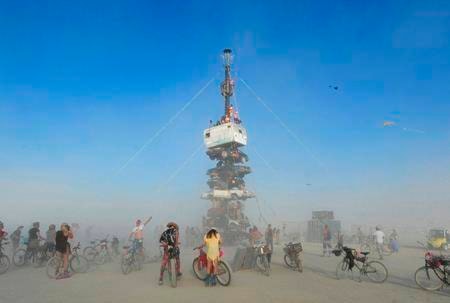RENO, Nev. — Breakfast, lunch and dinner at Burning Man is served with a side of playa dust that covers cars and clothing and finds its way into places where the sun doesn’t shine.
But experts say it doesn’t appear to pose any significant health risk to those who inhale it during the annual counter-culture festival in the desert 100 miles (160 kilometres) north of Reno, according to the Reno Gazette Journal.
Masks, bandannas and bedazzled respirators are wrapped around Burners’ faces in an effort to keep the chalk out of their mouths and nostrils, but the fashionable flair is often futile.
“Your eyelashes are covered, your clothes are covered - all the clothes you wear, they’re impossible to clean again,” said Wendover Brown, a frequent Burner who co-founded a fashionable protective mask company, Vogmask. “It’s such a fine dust, those microscopic particles, they get into everything.”
Since 1990, Burning Man has been held on the Black Rock Desert playa, an ancient lake flat made of alkaline dust. As the event has grown from a few hundred to tens of thousands of attendees, the increased vehicle and foot traffic has led to more frequent dust storms.
“Normally, you could see 2 miles (3.22 kilometres) on a clear day on the playa. During a dust storm, you can only see 2 yards (1.83 metres),” Brown said.
Air quality studies have found that the air quality at Burning Man during the peak days of the event is atrocious, far exceeding national air quality standards all days during the event and during many of the days leading up to it, when staff, volunteers and artists are on-site.
The most recently published air quality data was collected at Burning Man 2017, and the concentration of particulate matter — which can be anything from dust to smoke and ash — was so high that it at times maxed out the monitoring instruments, according to a 2019 environmental report by the Bureau of Land Management.
During seven of nine days, the measurement of larger particulate matter exceeded 600 micrograms per cubic meter, which typically warrants a hazard notice — indicating the highest level of danger — from air quality officials. The measurement of smaller particulate matter reached hazard levels as well, exceeding 250 micrograms per cubic meter, on five days of the event.
Brendan Schnieder, an air quality specialist with Washoe County, noted that Burning Man coincided with a wildfire in 2017, so levels of larger particulate matter were especially high.
“If this is a typical week at Burning Man, it would be a concern … but I think people understand that, and a lot of them stay inside” their RVs or other shelters, he said.
Dr. Aleem Surani, a pulmonary medical specialist at the Northern Nevada Medical Group, said short-term exposure to playa dust is unlikely to cause any long-term health effects, even if repeated.
“Based on what I can extrapolate from, there’s no significant concern for the average person going to Burning Man,” Surani said.
Surani said it’s hard to say with certainty that there are no effects because the research isn’t there. Most research focuses on prolonged, repeated exposure over decades, generally in workplaces such as mines, construction sites and agricultural facilities.
Granted, anyone attending Burning Man with pre-existing conditions, such as asthma, should use extra caution, he said. Children and elderly people also should attend with caution.
“People are going to probably have gunk in their mouth and throat, and hopefully they’re drinking lots of water and taking it easy during the wind,” he said. He said a doctor visit is recommended if any effects of breathing in dust persist beyond a week or two.
